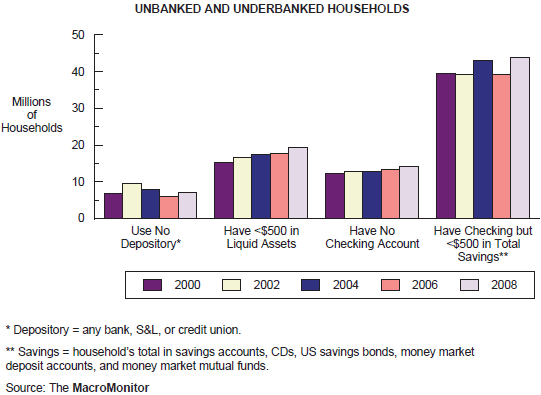MacroMonitor Market Trends November 2010
MacroMonitor Market Trends is a newsletter from Consumer Financial Decisions that highlights topical news and trends of interest to you and your colleagues. If you would like more information about the topic in the newsletter or would like to discuss other ways that we can assist you in your research and marketing efforts, please contact us.
The Unbanked and the Underbanked
At a time when competition for profits from serving affluent and middle-market households is intense—and regulations prohibit the largest institutions from engaging in any mergers or acquisitions—financial institutions may want to reconsider the possible profit potential of the 46% of all US households that are unserved or underserved: the unbanked and the underbanked. Fourteen million households have no checking account. Forty-four million households have a checking account but have less than $500 in total savings. The sheer size of the unbanked and the underbanked markets suggests that financial institutions can make profits. Institutions interested in serving these households will require an in-depth understanding of these households’ complete financial needs and be willing to deliver creative solutions that move households away from the edge of insolvency.
The first challenge is to identify and size the unbanked and the underbanked populations; the MacroMonitor is uniquely able to do so. The four relevant populations are unbanked households—households with no relationship with any bank, S&L, or credit union—and three populations of underbanked households: households with liquid assets of $500 or less, households with no checking account, and households that have a checking account but have less than $500 in all their savings. Between 2000 and 2008, the number of households in each of the four groups increased. Given the economic upheaval of the past two years, no reason exists to believe that the upward trend in the numbers of unbanked and underbanked households will decline in 2010.

The number of unbanked and underbanked households implies that a large proportion of households are living on the edge. In general, both types of households are more likely than banked households to have annual incomes of $25,000 or less and a household head with a high school diploma (or equivalent) or less. Unbanked households, households with low liquid assets, and households with no checking account are more likely than all households to be headed by a person 35 years of age or younger, to be a single or cohabiting household, and to have an unemployed or looking-for-work household head. A high proportion of unbanked household heads are younger than age 35; a high proportion also are older than age 75.
Two fairly recent San Francisco, California–based programs are bringing the unbanked and the underbanked into the financial-industry mainstream: the Earned Assets Resource Network (EARN) and the Bank on San Francisco. Between the two programs, four-year results are impressive: 50,000 formerly unbanked San Francisco residents have opened accounts. During the second quarter of 2011, the U.S. Treasury Department plans to launch a Bank on USA program modeled on Bank on San Francisco (Time Magazine, 1 November 2010; www.time.com/time/magazine/article/0,9171,2026894,00.html). Local and regional banks are best positioned to work with the Treasury, although a forward-thinking, major financial institution could more easily serve a wider swath of these populations through its network of existing branches.
To leverage economies of scale and to bundle the right products and services, institutions will require an understanding of the financial needs of unbanked and underbanked households. A study of these same households’ financial attitudes can direct efforts to develop effective education-outreach programs and marketing communications.
For more information, please contact CFD.